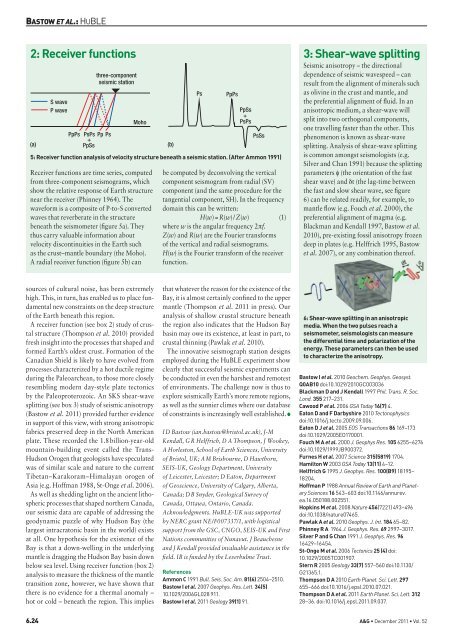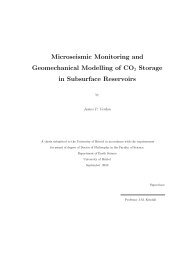The Hudson Bay Lithospheric Experiment - University of Bristol
The Hudson Bay Lithospheric Experiment - University of Bristol
The Hudson Bay Lithospheric Experiment - University of Bristol
Create successful ePaper yourself
Turn your PDF publications into a flip-book with our unique Google optimized e-Paper software.
BASTOW ET AL.: HUBLE2: Receiver functions(a)S waveP wavePpPs PsPs Pp Ps+PpSsthree-componentseismic stationMohoReceiver functions are time series, computedfrom three-component seismograms, whichshow the relative response <strong>of</strong> Earth structurenear the receiver (Phinney 1964). <strong>The</strong>waveform is a composite <strong>of</strong> P-to-S convertedwaves that reverberate in the structurebeneath the seismometer (figure 5a). <strong>The</strong>ythus carry valuable information aboutvelocity discontinuities in the Earth suchas the crust–mantle boundary (the Moho).A radial receiver function (figure 5b) candirect P wave(b)PsPpPsPpSs+PsPs5: Receiver function analysis <strong>of</strong> velocity structure beneath a seismic station. (After Ammon 1991)PsSsbe computed by deconvolving the verticalcomponent seismogram from radial (SV)component (and the same procedure for thetangential component, SH). In the frequencydomain this can be written:H(w) = R(w) / Z(w) (1)where w is the angular frequency 2f.Z(w) and R(w) are the Fourier transforms<strong>of</strong> the vertical and radial seismograms.H(w) is the Fourier transform <strong>of</strong> the receiverfunction.3: Shear-wave splittingSeismic anisotropy – the directionaldependence <strong>of</strong> seismic wavespeed – canresult from the alignment <strong>of</strong> minerals suchas olivine in the crust and mantle, andthe preferential alignment <strong>of</strong> fluid. In ananisotropic medium, a shear-wave willsplit into two orthogonal components,one travelling faster than the other. Thisphenomenon is known as shear-wavesplitting. Analysis <strong>of</strong> shear-wave splittingis common amongst seismologists (e.g.Silver and Chan 1991) because the splittingparameters (the orientation <strong>of</strong> the fastshear wave) and t (the lag-time betweenthe fast and slow shear wave, see figure6) can be related readily, for example, tomantle flow (e.g. Fouch et al. 2000), thepreferential alignment <strong>of</strong> magma (e.g.Blackman and Kendall 1997, Bastow et al.2010), pre-existing fossil anisotropy frozendeep in plates (e.g. Helffrich 1995, Bastowet al. 2007), or any combination there<strong>of</strong>.sources <strong>of</strong> cultural noise, has been extremelyhigh. This, in turn, has enabled us to place fundamentalnew constraints on the deep structure<strong>of</strong> the Earth beneath this region.A receiver function (see box 2) study <strong>of</strong> crustalstructure (Thompson et al. 2010) providedfresh insight into the processes that shaped andformed Earth’s oldest crust. Formation <strong>of</strong> theCanadian Shield is likely to have evolved fromprocesses characterized by a hot ductile regimeduring the Paleoarchean, to those more closelyresembling modern day-style plate tectonicsby the Paleoproterozoic. An SKS shear-wavesplitting (see box 3) study <strong>of</strong> seismic anisotropy(Bastow et al. 2011) provided further evidencein support <strong>of</strong> this view, with strong anisotropicfabrics preserved deep in the North Americanplate. <strong>The</strong>se recorded the 1.8 billion-year-oldmountain-building event called the Trans-<strong>Hudson</strong> Orogen that geologists have speculatedwas <strong>of</strong> similar scale and nature to the currentTibetan–Karakoram–Himalayan orogen <strong>of</strong>Asia (e.g. H<strong>of</strong>fman 1988, St-Onge et al. 2006).As well as shedding light on the ancient lithosphericprocesses that shaped northern Canada,our seismic data are capable <strong>of</strong> addressing thegeodynamic puzzle <strong>of</strong> why <strong>Hudson</strong> <strong>Bay</strong> (thelargest intracratonic basin in the world) existsat all. One hypothesis for the existence <strong>of</strong> the<strong>Bay</strong> is that a down-welling in the underlyingmantle is dragging the <strong>Hudson</strong> <strong>Bay</strong> basin downbelow sea level. Using receiver function (box 2)analysis to measure the thickness <strong>of</strong> the mantletransition zone, however, we have shown thatthere is no evidence for a thermal anomaly –hot or cold – beneath the region. This impliesthat whatever the reason for the existence <strong>of</strong> the<strong>Bay</strong>, it is almost certainly confined to the uppermantle (Thompson et al. 2011 in press). Ouranalysis <strong>of</strong> shallow crustal structure beneaththe region also indicates that the <strong>Hudson</strong> <strong>Bay</strong>basin may owe its existence, at least in part, tocrustal thinning (Pawlak et al. 2010).<strong>The</strong> innovative seismograph station designsemployed during the HuBLE experiment showclearly that successful seismic experiments canbe conducted in even the harshest and remotest<strong>of</strong> environments. <strong>The</strong> challenge now is thus toexplore seismically Earth’s more remote regions,as well as the sunnier climes where our database<strong>of</strong> constraints is increasingly well established. ●I D Bastow (ian.bastow@bristol.ac.uk), J-MKendall, G R Helffrich, D A Thompson, J Wookey,A Horleston, School <strong>of</strong> Earth Sciences, <strong>University</strong><strong>of</strong> <strong>Bristol</strong>, UK; A M Brisbourne, D Hawthorn,SEIS-UK, Geology Department, <strong>University</strong><strong>of</strong> Leicester, Leicester; D Eaton, Department<strong>of</strong> Geoscience, <strong>University</strong> <strong>of</strong> Calgary, Alberta,Canada; D B Snyder, Geological Survey <strong>of</strong>Canada, Ottawa, Ontario, Canada.Acknowledgments. HuBLE-UK was supportedby NERC grant NE/F007337/1, with logisticalsupport from the GSC, CNGO, SEIS-UK and FirstNations communities <strong>of</strong> Nunavut. J Beauchesneand J Kendall provided invaluable assistance in thefield. IB is funded by the Leverhulme Trust.ReferencesAmmon CBull. Seis. Soc. Am. 81(6)Bastow I et al.Geophys. Res. Lett. 34(5)Bastow I et al.Geology 39(1)6: Shear-wave splitting in an anisotropicmedia. When the two pulses reach aseismometer, seismologists can measurethe differential time and polarization <strong>of</strong> theenergy. <strong>The</strong>se parameters can then be usedto characterize the anisotropy.Bastow I et al.Geochem. Geophys. Geosyst.Q0AB10Blackman D and J KendallPhil. Trans. R. Soc.Lond. 355Cawood P et al. GSA Today 16(7)Eaton D and F DarbyshireTectonophysicsEaton D J et al. EOS Transactions 86Fouch M A et al. J. Geophys Res. 105Furnes H et al. Science 315(5819)Hamilton WGSA Today 13(11)Helffrich G J. Geophys. Res. 100(B9)H<strong>of</strong>fman PAnnual Review <strong>of</strong> Earth and PlanetarySciences 16Hopkins M et al. Nature 456Pawlak A et al. Geophys. J. Int. 184Phinney R A J. Geophys. Res. 69Silver P and G Chan J. Geophys. Res. 96St-Onge M et al. Tectonics 25 (4)Stern R Geology 33(7)Thompson D A Earth Planet. Sci. Lett. 297Thompson D A et al.Earth Planet. Sci. Lett. 3126.24 A&G











